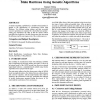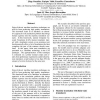222 search results - page 3 / 45 » Gesture Modeling and Recognition Using Finite State Machines |
ACL
1997
13 years 7 months ago
1997
Although adequate models of human language for syntactic analysis and semantic interpretation are of at least contextfree complexity, for applications such as speech processing in...
ALT
2005
Springer
2005
Springer
PAC-Learnability of Probabilistic Deterministic Finite State Automata in Terms of Variation Distance
14 years 2 months ago
We consider the problem of PAC-learning distributions over strings, represented by probabilistic deterministic finite automata (PDFAs). PDFAs are a probabilistic model for the gen...
GECCO
2006
Springer
13 years 9 months ago
2006
Springer
A Genetic Algorithm, embedded in a simulation-based method, is applied to the identification of Asynchronous Finite State Machines. Two different coding schemes and their associat...
EMNLP
2004
13 years 7 months ago
2004
State-of-the-art machine translation techniques are still far from producing high quality translations. This drawback leads us to introduce an alternative approach to the translat...
DSRT
2008
IEEE
14 years 7 days ago
2008
IEEE
Security and reliability are of paramount importance in designing and building real-time systems because any security failure can put the public and the environment at risk. In th...


